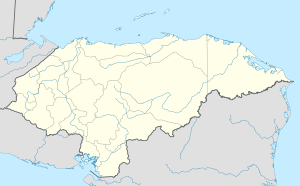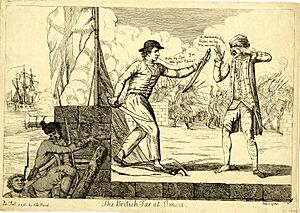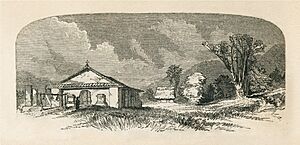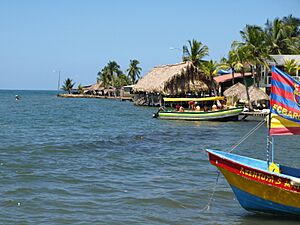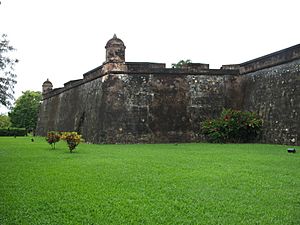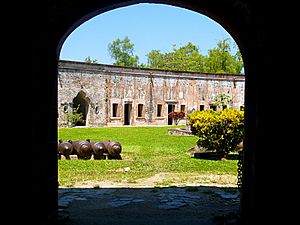Omoa facts for kids
Quick facts for kids
Omoa
Omoa
|
|
|---|---|
|
Municipality
|
|
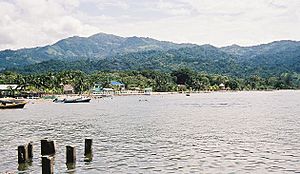 |
|
| Nickname(s):
Omoa
|
|
| Country | |
| Department | Cortés |
| Foundation | 1752 |
| Area | |
| • Municipality | 394 km2 (152 sq mi) |
| Population
(2023 projection)
|
|
| • Municipality | 58,172 |
| • Density | 147.64/km2 (382.4/sq mi) |
| • Urban | 30,334 |
| Climate | Af |
Omoa is a town and a special area (called a municipality) in Honduras. It's located in the Cortés Department. In 2023, about 10,550 people lived in the town itself. Omoa sits on a small bay on the Caribbean Sea coast. It's about 18 kilometers (11 miles) west of Puerto Cortés.
Contents
About Omoa's Location
Omoa is both a municipality and a small town. It is located along the northwest Caribbean coast of Honduras. The whole municipality covers an area of about 382.8 square kilometers (147.8 square miles). Around 30,000 people live in this area.
A Look at Omoa's Past
Early History of Omoa
In 1536, Omoa was a small village of native people. It was given to Luis del Puerto by Pedro de Alvarado. By 1582, the village had stopped existing as a strong community.
Building a New Port
Pirate attacks on Caribbean coastal towns were common. Because of this, the Spanish government started looking for a new safe port in 1590. This port would help them send goods from Captaincy General of Guatemala to Spain. Many studies showed that Omoa Bay was the best place for a strong port. It was the most defensible spot west of Trujillo, which already had a fort.
Omoa's Rebirth and Forts
Omoa was founded again in 1752 as a Spanish colonial town. The governor of Honduras at the time, Pantaleón Ibánez, planned for the town to have many important buildings. These included a hospital, a treasury building, a church, warehouses, and barracks for soldiers. The town was meant to house the people who would build and protect the two Spanish forts. These forts, named El Real and San Fernando de Omoa, would guard the bay.
Construction of Fort El Real began in 1752 and finished around 1756. This fort protected the port town while the much larger Fort San Fernando de Omoa was built next to it.
The Great Fortress of San Fernando
San Fernando de Omoa was completed around 1774. This large fortress was built mainly to protect against pirates. These pirates often targeted silver shipments from the mines of San Miguel of Tegucigalpa. The silver was often sent from Omoa to Spain. Interestingly, the fortress was finished after piracy had already started to decline.
After Honduras became independent in 1821, the fortress was used as a prison. It served this purpose until the 1950s. The English briefly took over the town in 1779 during the Battle of San Fernando de Omoa. They reportedly burned its 200 buildings.
People of Omoa
In the late 1700s, Omoa had a mix of people. There were Spanish settlers, native people (mostly from central Honduras), and enslaved Africans. The enslaved people were brought to build and maintain the fort. There were also mulattos and free Black people, many of whom were escaped English slaves from Belize.
Omoa's Changing Importance
For a long time, Omoa was one of the most important ports in Honduras. However, its importance began to lessen in the 1820s. The town was destroyed by fires a few times, and the bay started to fill with sand. Also, the nearby port of Puerto Cortes began to grow. In the 1880s, the first railroad connected Puerto Cortes with San Pedro Sula. This made Omoa less important, and it became mostly a fishing village.
Omoa's Economy Today
In the past, Omoa had a cattle industry, raising cows mostly for use in Honduras. Today, Omoa has a large fishing industry. Many people earn money from fishing.
Another important source of income comes from tourism. Visitors come to see the historic Fortress of San Fernando. This is the largest colonial fortress in Central America. It is also one of the few old colonial fortresses still standing in the Americas.
The San Fernando Fortress
Omoa's most famous landmark is the Fortaleza de San Fernando de Omoa. This is a Spanish fort built in the 1700s. There were actually two forts built here. The first one, Fort Real, was started in 1752 and improved in 1759. The larger Fort of San Fernando de Omoa was built next to it from 1756 to 1775.
In 1757, a Spanish Navy ship with 18 guns, also named San Fernando, was built here.
The British Attack of 1779
On October 15, 1779, British Royal Navy ships, including HMS Lowestoffe and HMS Charon, arrived off the coast of Honduras. They hoped to capture Spanish treasure ships in the bay. They found two Spanish ships hiding near the San Fernando de Omoa fortress. The British first tried to capture the town from the sea, but it didn't work.
On October 16, British sailors, marines, and soldiers landed about 9 miles away. They marched through swamps and mountains to attack Omoa by land. It was a difficult march, but they reached the town the next afternoon and quickly took it. However, they couldn't take the fort because they had lost their scaling ladders.
The British ships continued to fire at the fort from the sea. On the night of October 19, British storming parties quietly entered the fort. They surprised the Spanish defenders, and the fort was captured with only six British injuries.
Inside the fort and on the two treasure ships, the British found a huge amount of treasure. It was worth about two million dollars! They also found 14 metric tons of mercury in the fort. The British left the fort at the end of November before a Spanish counterattack could arrive. You can still see the craters from the British cannon fire on the fort's walls today.
After Independence
Omoa was the last place in Central America still controlled by Spain after the region declared its independence. The Spanish fort was later captured by the Central American Republicans, led by Colonel Juan Galindo.
Surviving Hurricane Fifi
In 1974, Hurricane Fifi destroyed much of the town of Omoa. The fort was one of the few buildings left standing. After the hurricane, it became a key location for rescue operations.
See also
 In Spanish: Omoa para niños
In Spanish: Omoa para niños


